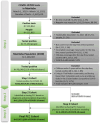Identifying people with post-COVID condition using linked, population-based administrative health data from Manitoba, Canada: prevalence and predictors in a cohort of COVID-positive individuals
- PMID: 39788761
- PMCID: PMC11751946
- DOI: 10.1136/bmjopen-2024-087920
Identifying people with post-COVID condition using linked, population-based administrative health data from Manitoba, Canada: prevalence and predictors in a cohort of COVID-positive individuals
Abstract
Objective: Many individuals exposed to SARS-CoV-2 experience long-term symptoms as part of a syndrome called post-COVID condition (PCC). Research on PCC is still emerging but is urgently needed to support diagnosis, clinical treatment guidelines and health system resource allocation. In this study, we developed a method to identify PCC cases using administrative health data and report PCC prevalence and predictive factors in Manitoba, Canada.
Design: Cohort study.
Setting: Manitoba, Canada.
Participants: All Manitobans who tested positive for SARS-CoV-2 during population-wide PCR testing from March 2020 to December 2021 (n=66 365) and were subsequently deemed to have PCC based on International Classification of Disease-9/10 diagnostic codes and prescription drug codes (n=11 316). Additional PCC cases were identified using predictive modelling to assess patterns of health service use, including physician visits, emergency department visits and hospitalisation for any reason (n=4155).
Outcomes: We measured PCC prevalence as % PCC cases among Manitobans with positive tests and identified predictive factors associated with PCC by calculating odds ratios with 95% confidence intervals, adjusted for sociodemographic and clinical characteristics (aOR).
Results: Among 66 365 Manitobans with positive tests, we identified 15 471 (23%) as having PCC. Being female (aOR 1.64, 95% CI 1.58 to 1.71), being age 60-79 (aOR 1.33, 95% CI 1.25 to 1.41) or age 80+ (aOR 1.62, 95% CI 1.46 to 1.80), being hospitalised within 14 days of COVID-19 infection (aOR 1.95, 95% CI 1.80 to 2.10) and having a Charlson Comorbidity Index of 1+ (aOR 1.95, 95% CI 1.78 to 2.14) were predictive of PCC. Receiving 1+ doses of the COVID-19 vaccine (one dose, aOR 0.80, 95% CI 0.74 to 0.86; two doses, aOR 0.29, 95% CI 0.22 to 0.31) decreased the odds of PCC.
Conclusions: This data-driven approach expands our understanding of the prevalence and epidemiology of PCC and may be applied in other jurisdictions with population-based data. The study provides additional insights into risk and protective factors for PCC to inform health system planning and service delivery.
Keywords: COVID-19; Epidemiology; Post-Acute COVID-19 Syndrome; SARS-CoV-2 Infection.
© Author(s) (or their employer(s)) 2025. Re-use permitted under CC BY-NC. No commercial re-use. See rights and permissions. Published by BMJ Group.
Conflict of interest statement
Competing interests: None declared.
Figures
Similar articles
-
COVID-19 diagnostic testing and vaccinations among First Nations in Manitoba: A nations-based retrospective cohort study using linked administrative data, 2020-2021.PLoS Med. 2024 Feb 16;21(2):e1004348. doi: 10.1371/journal.pmed.1004348. eCollection 2024 Feb. PLoS Med. 2024. PMID: 38363739 Free PMC article.
-
Psychiatric Symptoms, Treatment Uptake, and Barriers to Mental Health Care Among US Adults With Post-COVID-19 Condition.JAMA Netw Open. 2024 Apr 1;7(4):e248481. doi: 10.1001/jamanetworkopen.2024.8481. JAMA Netw Open. 2024. PMID: 38662370 Free PMC article.
-
Association of Treatment With Nirmatrelvir and the Risk of Post-COVID-19 Condition.JAMA Intern Med. 2023 Jun 1;183(6):554-564. doi: 10.1001/jamainternmed.2023.0743. JAMA Intern Med. 2023. PMID: 36951829 Free PMC article.
-
Universal screening for SARS-CoV-2 infection: a rapid review.Cochrane Database Syst Rev. 2020 Sep 15;9(9):CD013718. doi: 10.1002/14651858.CD013718. Cochrane Database Syst Rev. 2020. PMID: 33502003 Free PMC article.
-
Signs and symptoms to determine if a patient presenting in primary care or hospital outpatient settings has COVID-19.Cochrane Database Syst Rev. 2021 Feb 23;2(2):CD013665. doi: 10.1002/14651858.CD013665.pub2. Cochrane Database Syst Rev. 2021. Update in: Cochrane Database Syst Rev. 2022 May 20;5:CD013665. doi: 10.1002/14651858.CD013665.pub3. PMID: 33620086 Free PMC article. Updated.
References
-
- World Health Organization COVID-19 epidemiological update 2024. coronavirus disease (covid-19) weekly epidemiological updates and monthly operational updates. 2024. [8-Feb-2024]. https://www.who.int/publications/m/item/covid-19-epidemiological-update-... Available. Accessed.
-
- Centers for Disease Control and Prevention Post-covid/long covid. 2020. [29-Mar-2021]. https://www.idsociety.org/covid-19-real-time-learning-network/disease-ma... Available. Accessed.
MeSH terms
LinkOut - more resources
Full Text Sources
Medical
Miscellaneous


